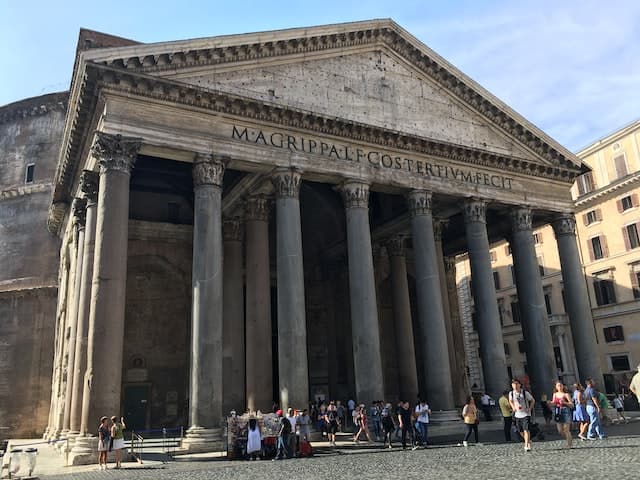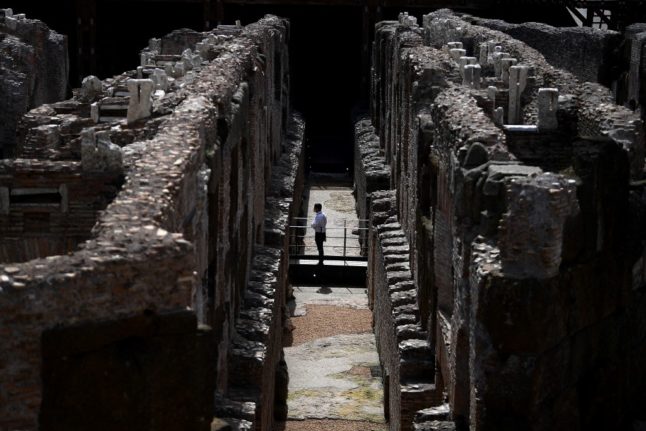La Bella Vita: Untranslatable Italian words and visiting Rome’s Pantheon and Colosseum

From making the most of a visit to Rome's famous sights to understanding Italian words that have no English equivalent, our weekly newsletter La Bella Vita offers you an essential starting point for eating, talking, drinking and living like an Italian.
La Bella Vita is our regular look at the real culture of Italy – from language to cuisine, manners to art. This new newsletter will be published weekly and you can receive it directly to your inbox, by going to newsletter preferences in 'My Account' or follow the instructions in the newsletter box below.
As we wrote last week, tourism in Italy is set to return to pre-pandemic levels in 2023, and if you’re in central Rome at the moment you could be forgiven for thinking the whole world has arrived at once. Last weekend, crowds flocked to enjoy the famous sights again in the early spring sunshine and Piazza della Rotonda was packed out with people admiring or waiting for entry to the Pantheon. You do need to reserve a slot in advance if you plan to visit the Pantheon on busy weekend days, but entry is free - for now, at least, as Italy’s culture ministry announced this week that the Pantheon will soon start charging visitors a fee for entry. They didn’t say how much it will cost - though it will be “no more than five euros”, the ministry said, and Rome residents and those attending mass will be exempt.
The plan has divided opinion among visitors, with some tourists saying they don’t mind paying a couple of euros towards the monument’s upkeep, while many Italians are furious at the proposal and insist such sites should remain free and open to all. The strength of feeling among those who are against the idea might be surprising, but this is mainly due to the widespread Italian ideal of ‘bene pubblico artistico-culturale’; you can read more about this long-running debate in our feature below:
Why is Italy’s plan to charge for entry to the Pantheon so controversial?
And whether it’s your first or fifteenth trip to Rome, you won't want to leave without making a stop at the Colosseum. If you’ve already seen the arena itself, it’s worth going back on a tour or different ticket type to visit the upper floors, the nearby Roman Forum and Palatine Hill, and a range of other lesser-known sights in the complex. On certain dates you can even see the Colosseum by night, which really is magical.
During busy periods though the area around the Colosseum can be hectic, and you’ll need to plan ahead to get the most out of your trip. Here's our quick guide to a hassle-free visit.
How to visit the Colosseum in Rome
 A visitor stands in the hypogeum, or underground area, of the Colosseum. Photo by Filippo MONTEFORTE / AFP.
A visitor stands in the hypogeum, or underground area, of the Colosseum. Photo by Filippo MONTEFORTE / AFP.
If you'd rather escape from the cities and explore Italy's natural sights in the countryside and national parks, spring means the perfect weather for camping. But pitching a tent is definitely not the number one way for Italians to spend their holidays, so you might think campsites - at least good ones - are few and far between. While there aren't always as many options as you'd find in some European countries, Italy is still a great option for a camping holiday. We've put together a guide to planning yours:
How to plan a camping holiday in Italy: a guide for the uninitiated
More humble and less fussy than French cuisine, Italy’s cucina povera makes use of minimal ingredients, prioritising fresh local produce over complex cooking techniques - which essentially means you'll eat very well in Italy without necessarily spending a fortune.
But while it's not as elaborate as its Gallic counterpart, even an informal Italian lunch is still traditionally a multi-course affair, often stretching over several leisurely hours and involving various stages and countless plates.
If you’re invited into an Italian home for lunch or dinner, you’re likely to find it a relaxed occasion that may include all or just some of the courses listed in our article below – though you can expect it to be lengthy and abundant.
Antipasto to amaro: What to expect from every step of an Italian dinner
Every language has words and phrases that don't translate easily, and Italian is no exception. You might just find a new favourite Italian word or two on our list of the most interesting words that can't be translated into English (and which often tell us a lot about Italian culture, too).
The top ten Italian words that just don’t translate into English
Remember if you'd like to have this weekly newsletter sent straight to your inbox you can sign up for it via Newsletter preferences in "My Account".
Is there an aspect of the Italian way of life you'd like to see us write more about on The Local? Please email me at [email protected].
Comments
See Also
La Bella Vita is our regular look at the real culture of Italy – from language to cuisine, manners to art. This new newsletter will be published weekly and you can receive it directly to your inbox, by going to newsletter preferences in 'My Account' or follow the instructions in the newsletter box below.
As we wrote last week, tourism in Italy is set to return to pre-pandemic levels in 2023, and if you’re in central Rome at the moment you could be forgiven for thinking the whole world has arrived at once. Last weekend, crowds flocked to enjoy the famous sights again in the early spring sunshine and Piazza della Rotonda was packed out with people admiring or waiting for entry to the Pantheon. You do need to reserve a slot in advance if you plan to visit the Pantheon on busy weekend days, but entry is free - for now, at least, as Italy’s culture ministry announced this week that the Pantheon will soon start charging visitors a fee for entry. They didn’t say how much it will cost - though it will be “no more than five euros”, the ministry said, and Rome residents and those attending mass will be exempt.
The plan has divided opinion among visitors, with some tourists saying they don’t mind paying a couple of euros towards the monument’s upkeep, while many Italians are furious at the proposal and insist such sites should remain free and open to all. The strength of feeling among those who are against the idea might be surprising, but this is mainly due to the widespread Italian ideal of ‘bene pubblico artistico-culturale’; you can read more about this long-running debate in our feature below:
Why is Italy’s plan to charge for entry to the Pantheon so controversial?
And whether it’s your first or fifteenth trip to Rome, you won't want to leave without making a stop at the Colosseum. If you’ve already seen the arena itself, it’s worth going back on a tour or different ticket type to visit the upper floors, the nearby Roman Forum and Palatine Hill, and a range of other lesser-known sights in the complex. On certain dates you can even see the Colosseum by night, which really is magical.
During busy periods though the area around the Colosseum can be hectic, and you’ll need to plan ahead to get the most out of your trip. Here's our quick guide to a hassle-free visit.
How to visit the Colosseum in Rome

If you'd rather escape from the cities and explore Italy's natural sights in the countryside and national parks, spring means the perfect weather for camping. But pitching a tent is definitely not the number one way for Italians to spend their holidays, so you might think campsites - at least good ones - are few and far between. While there aren't always as many options as you'd find in some European countries, Italy is still a great option for a camping holiday. We've put together a guide to planning yours:
How to plan a camping holiday in Italy: a guide for the uninitiated
More humble and less fussy than French cuisine, Italy’s cucina povera makes use of minimal ingredients, prioritising fresh local produce over complex cooking techniques - which essentially means you'll eat very well in Italy without necessarily spending a fortune.
But while it's not as elaborate as its Gallic counterpart, even an informal Italian lunch is still traditionally a multi-course affair, often stretching over several leisurely hours and involving various stages and countless plates.
If you’re invited into an Italian home for lunch or dinner, you’re likely to find it a relaxed occasion that may include all or just some of the courses listed in our article below – though you can expect it to be lengthy and abundant.
Antipasto to amaro: What to expect from every step of an Italian dinner
Every language has words and phrases that don't translate easily, and Italian is no exception. You might just find a new favourite Italian word or two on our list of the most interesting words that can't be translated into English (and which often tell us a lot about Italian culture, too).
The top ten Italian words that just don’t translate into English
Remember if you'd like to have this weekly newsletter sent straight to your inbox you can sign up for it via Newsletter preferences in "My Account".
Is there an aspect of the Italian way of life you'd like to see us write more about on The Local? Please email me at [email protected].
Join the conversation in our comments section below. Share your own views and experience and if you have a question or suggestion for our journalists then email us at [email protected].
Please keep comments civil, constructive and on topic – and make sure to read our terms of use before getting involved.
Please log in here to leave a comment.